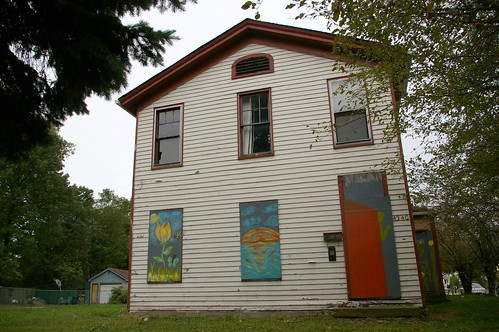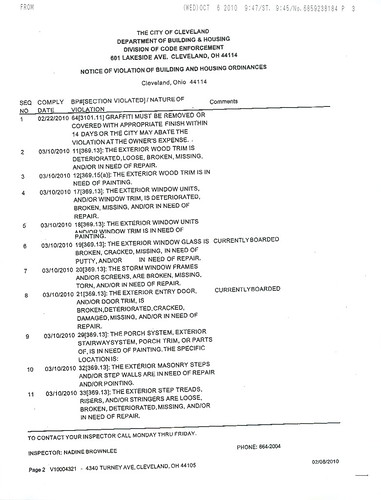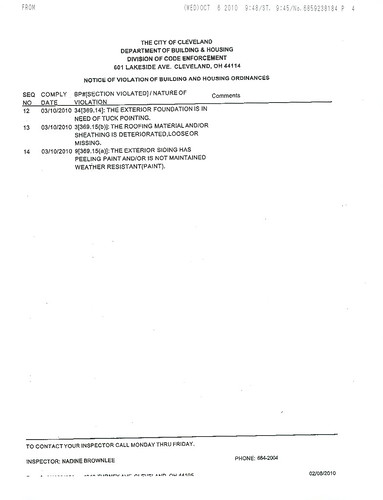
Last week you learned about the history of this historic Cleveland home, built circa 1855, at 4340 Turney Road. This important structure marked the transition of this area from rural to urban. As it is right now, it might be demolished - the owner has pulled a demolition permit rather than deal with the code violations - so action is needed soon.
Perhaps you were scared off by the prospect of addressing the code violations. Given the state of some houses, this seems perfectly reasonable. I've obtained a list of the violations and found them to be quite managable. Note: I've omitted page 1 because it does not contain any actual violations.


As a whole, the violations don't seem that prohibitive. My description of the violations is followed by two tables - one for the cost of the materials (or labor) another for the cost of the tools (if you don't already own them).
Exterior paint - Items 1, 3, 5, 9, and 14
By my calculations, the exterior of the house is 2300 square feet. A major home improvement chain (which I will be using for the remainder of the estimates unless noted otherwise) lists a quality paint at $120 per 5 gallon bucket (covering 2,000 square feet) - assume 10 gallons - $240. Some of the wood will need to be scraped of peeling paint and then primed - assume $150 in tools for scraping and sanding and 4 gallons of primer (two 2 gallon buckets) ($40). Add another $50 for two gallons of exterior trim paint. Finally, you'll need apply the paint - $75 to rent a spray gun and $80 for three good quality brushes.
Broken window glass - Item 6
Five windows are obviously broken, which should be fixable for $100 of materials. For this budget, let's assume that another 20 need to be fixed and say $500, total.
Masonry repair - Items 10, 11, and 12
There has been considerable deterioration to the mortar on the foundation. It needs to be repointed with historically appropriate lime-based mortar, as do the steps. (Most of what you'll find at the store today is cement-based, which is considerably harder than what was used historically. It will cause damage to the stone or brick.) Assume $250 for the mortar and another $50 for basic tools.
Exterior trim - Items 2, 4, 8
The wood trim appears to be in good condition. Some areas, where there is peeling paint, could require work. Just about all of the exterior is basic wood siding or rectangular trim. There isn't any fancy moulding that would be expensive to replicate. Metro Hardwoods has a reputation for reasonable pricing, such that one might replace the damaged wood trim with hardwood lumber, as it would have been when it was built, for, at the most, $1,500.
Expect to spend another $500 on a decent table saw and good blades to go with. Don't skimp on the blades.
Storm window frames and screens - Item 7
Several of the windows with storm frames appear to lack storms or screens. It's quite possible that they are inside the house and just not installed. The cheapest way to fix this violation would be to remove the storm window frames and, at some future date, fabricate more aesthetically appropriate ones. Screens themselves are easy enough to replace, and cheap, too. If more work is required, we can assume a higher cost - at the high end, to make it legal, $1,000.
Roof - Item 13
I am unsure of the extent of the problems with the roof. At the worst case scenario, a full tear-off and re-roof might be required. This calculator estimates a cost of $7500-$9,000 to do this and install a 40 year dimensional shingle.
| Materials | |
| Lumber, exterior trim and siding | $1,500 |
| Mortar and supplies | $250 |
| Paint, Exterior - 10 gallons | $240 |
| Paint, Trim - 2 gallons | $50 |
| Primer, 4 gallons | $40 |
| Storm window and screen repairs | $0-1,000 |
| Window glass and glazing compound | $500 |
| | |
| Tools | |
| Extension ladder | $100-200 |
| For scraping and sanding paint | $150 |
| Paint spray gun rental | $75 |
| Paint brushes | $80 |
| For mortar work | $50 |
| Table saw and blades | $500 |
| | |
| Other | |
| Roof, new, with tear-off | $7,500-$9,000 |
| | |
| Total | $11,035-$14,635 |
Other obvious concerns
There are other issues, of course, that one might need to address. There are some missing gutters and downspouts. There are deteriorated basement windows.
There's the tree growing into the foundation at the rear. It's worth noting that while the main part of the rear of the house is historic, the part that the tree is growing into is an early 20th century addition. It might be worth considering whether, at this point, it might be better to remove it. The same could be said for the second floor porch, which, like all porches, surely suffers some moisture issues.
The interior, from what I've seen, seems managable. While I'm usually in favor of retaining original plaster, it might make more sense to just put a layer of quarter inch drywall on the ceiling rather than deal with the peeling paint.
The plumbing, from what I can see based on the locations of vents in the roof, appears to all be in the rear part of the house. It would be less work to replace than in a larger house or a structure where plumbing was spread out throughout the whole house.
Of course, one could surely spend much much more than the price I have suggested fixing up this (or any) structure. There will be problems that show up that have not been considered, and there will be cost overruns.
The cost fixing the existing code violations does not seem so daunting as to be insurmountable. Think about the history of this structure and the position that it occupies in this neighborhood and consider taking on this historic property. It's a significant part of our local history.




Good work Christopher--you now see how easy it is the get B&H to condemn a property, especially if a developer wants land cleared at tax payer expense. This owner is willing to pay the demo him/herself? I am surprised. If the cost as you have broken out is equivalent to demolition costs...what about the taxes owed on this property? My guess would be that the owner will not be paying taxes for as long as possible--to take advantage of the City of Cleveland clearing the lot for him/her. "Owner" could also just be a strawbuyer in this case--waiting out the demise of the property, so Rokakis could keep tacking on the lien and the demo lien. It's all a complex game for carpetbaggers.
ReplyDeleteI think I missed where the labor (scraping, priming, painting, additional woodworking) was calculated. Isn't that the expensive part?
ReplyDeleteBBC - for the record, this house has not been condemened.
ReplyDeleteJeffrey -
Sure, labor is expensive, if you're paying someone else. But if you want to live in a beautiful house in the city, and preserve a piece of our region's history, maybe that's what you decide you want to do with your time.
I know plenty of people who live in older houses, and who have done quite a bit of work fixing them up. While one might be able to break even in the long run with regard to the cost of materials, I've yet to find private individuals who could break even if they figured the labor they put into their houses at a reasonable hourly rate. This is true across the board, from smaller houses in the city of Cleveland to larger ones in Cleveland Heights or Shaker Heights.
It's the masonry that is very expensive unless you are a skilled mason. Materials are cheap, but a masonry job of that kind would probably be $2,700 or more. It could be a dangerous job for an amateur? electrical work, and plumbing would also need to be considered for a safe working environment...but it's nice to see a break down for an idea. (I have a roofing ladder if anyone needs to borrow it.) Our code violations were seemingly minor, but it was about $14,500 to fix everything that we couldn't do ourselves.
ReplyDelete